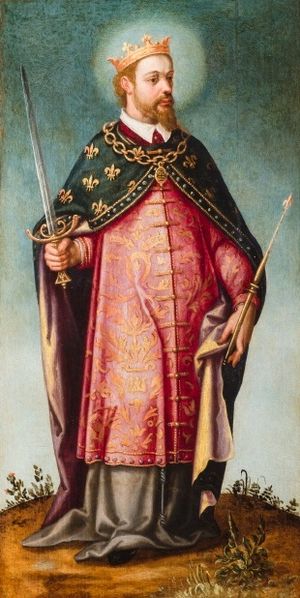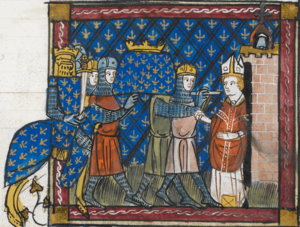Louis IX of France facts for kids
Quick facts for kids Louis IX |
|
|---|---|

Contemporary depiction from about 1230
|
|
| King of France (more...) | |
| Reign | 8 November 1226 – 25 August 1270 |
| Coronation | 29 November 1226 in Reims Cathedral |
| Predecessor | Louis VIII |
| Successor | Philip III |
| Regents |
See list
|
| Born | 25 April 1214 Poissy, France |
| Died | 25 August 1270 (aged 56) Tunis, North Africa |
| Burial | Basilica of St Denis |
| Spouse | |
| Issue among others... |
|
| House | Capet |
| Father | Louis VIII, King of France |
| Mother | Blanche of Castile |
| Religion | Roman Catholicism |
Louis IX (25 April 1214 – 25 August 1270), commonly known as Saint Louis or Louis the Saint, was King of France from 1226 to 1270, and the most illustrious of the Direct Capetians. He was crowned in Reims at the age of 12, following the death of his father Louis VIII. His mother, Blanche of Castile, ruled the kingdom as regent until he reached maturity, and then remained his valued adviser until her death. During Louis' childhood, Blanche dealt with the opposition of rebellious vassals and secured Capetian success in the Albigensian Crusade, which had started 20 years earlier.
Louis IX enjoyed immense prestige throughout European Christendom. His reign is often remembered as an economic and political golden age for the Kingdom of France during the Middle Ages. He was largely admired by fellow European rulers and was sometimes asked to arbitrate disputes outside of his kingdom.
Louis IX reformed the French legal process. He created a royal justice system in which petitioners could appeal judgements directly to the king. He banned trials by ordeal, tried to end private wars, and introduced the presumption of innocence to criminal procedures. To enforce his new legal system, Louis IX created provosts and bailiffs.
Louis IX led the ill-fated Seventh Crusade and Eighth Crusade against the Muslim dynasties that ruled North Africa, Egypt and the Holy Land. He was captured and ransomed during the Seventh Crusade, and later died of dysentery during the Eighth Crusade. He was succeeded by his son Philip III.
His admirers through the centuries have regarded Louis IX as the ideal Christian ruler. His skill as a knight and engaging manner with the public made him popular, though contemporaries occasionally rebuked him as a "monk king". Despite his liberalizing legal reforms, Louis was a devout Christian and enforced strict Catholic orthodoxy. He passed severe laws punishing blasphemy and targeted France's Jews. He is the only canonized king of France.
Contents
Early life
Louis was born on 25 April 1214 at Poissy, near Paris, the son of Louis the Lion and Blanche of Castile, and was baptized there in La Collégiale Notre-Dame church. His grandfather on his father's side was Philip II, king of France; his grandfather on his mother's side was Alfonso VIII, king of Castile. Tutors of Blanche's choosing taught him Latin, public speaking, writing, military arts, and government. He was nine years old when his grandfather Philip II died and his father became King Louis VIII.
Louis was 12 years old when his father died on 8 November, 1226. He was crowned king within the month at Reims Cathedral. His mother, Blanche, ruled France as regent during his minority. Louis's mother was a devouted Christian. She is once recorded to have said:
I love you, my dear son, as much as a mother can love her child; but I would rather see you dead at my feet than that you should ever commit a mortal sin.
His younger brother Charles I of Sicily (1227–85) was created count of Anjou, thus founding the Capetian Angevin dynasty.
While his contemporaries viewed his reign as co-rule between the king and his mother, historians generally believe Louis began ruling personally in 1234, and his mother assumed a more advisory role. She continued to have a strong influence on the king until her death in 1252.
Marriage
On 27 May 1234, Louis married Margaret of Provence (1221–1295); she was crowned in the cathedral of Sens the next day. Margaret was the sister of Eleanor of Provence, who later married Henry III of England. The new queen's religious zeal made her a well-suited partner for the king. They got along well, enjoying riding together, reading, and listening to music. His closeness to Margaret aroused jealousy in his mother, who tried to keep the couple apart as much as she could.
The Crusades of Saint Louis
In 1229, when Louis was 15, his mother ended the Albigensian Crusade by signing an agreement with Raymond VII of Toulouse. Raymond VI of Toulouse had been suspected of ordering the assassination of Pierre de Castelnau, a Roman Catholic preacher who attempted to convert the Cathars.
Louis went on two crusades: the Seventh Crusade in 1248 and the Eighth Crusade in 1270.
Children
- Blanche (12 July/4 December 1240 – 29 April 1244), died in infancy.
- Isabella (2 March 1241 – 28 January 1271), married Theobald II of Navarre.
- Louis (23 September 1243/24 February 1244 – 11 January/2 February 1260). Betrothed to Berengaria of Castile in Paris on 20 August 1255.
- Philip III (1 May 1245 – 5 October 1285), married firstly to Isabella of Aragon in 1262 and secondly to Maria of Brabant in 1274.
- John (1246/1247 – 10 March 1248), died in infancy.
- John Tristan (8 April 1250 – 3 August 1270), Count of Valois, married Yolande II, Countess of Nevers.
- Peter (1251 – 6/7 April 1284), Count of Perche and Alençon, married Joanne of Châtillon.
- Blanche (early 1253 – 17 June 1320), married Ferdinand de la Cerda, Infante of Castile.
- Margaret (early 1255 – July 1271), married John I, Duke of Brabant.
- Robert (1256 – 7 February 1317), Count of Clermont, married Beatrice of Burgundy. The French crown devolved upon his male-line descendant, Henry IV (the first Bourbon king), when the legitimate male line of Philip III died out in 1589.
- Agnes (1260 – 19/20 December 1327), married Robert II, Duke of Burgundy.
Louis and Margaret's two children who died in infancy were first buried at the Cistercian abbey of Royaumont. In 1820 they were transferred and reinterred to Saint-Denis Basilica.
Death and legacy
Louis died at Tunis on 25 August 1270, in an epidemic of dysentery that swept through his army. His remains were returned to France. Louis was succeeded as King of France by his son, Philip III.
Veneration as a saint
| Saint Louis |
|
|---|---|

San Luis, Rey de Francia (English: Saint Louis, King of France) by Francisco Pacheco
|
|
| King of France Confessor |
|
| Venerated in | Catholic Church Anglican Communion |
| Canonized | 11 July 1297, Rome, Papal States by Pope Boniface VIII |
| Feast | 25 August |
| Attributes | The Crown of Thorns, crown, sceptre, globus cruciger, sword, fleur-de-lis, mantle, and the other parts of the French regalia |
| Patronage |
|
Pope Boniface VIII proclaimed the canonization of Louis in 1297; he is the only French king to be declared a saint. Louis IX is often considered the model of the ideal Christian monarch.
When he became king, over a hundred poor people were served meals in his house on ordinary days. Often the king served these guests himself. His acts of charity, coupled with his devout religious practices, gave rise to the legend that he joined the Third Order of St. Francis, though it is unlikely that he ever actually joined the order.
The Episcopal Church honors him with a feast day on August 25.
See also
 In Spanish: Luis IX de Francia para niños
In Spanish: Luis IX de Francia para niños


